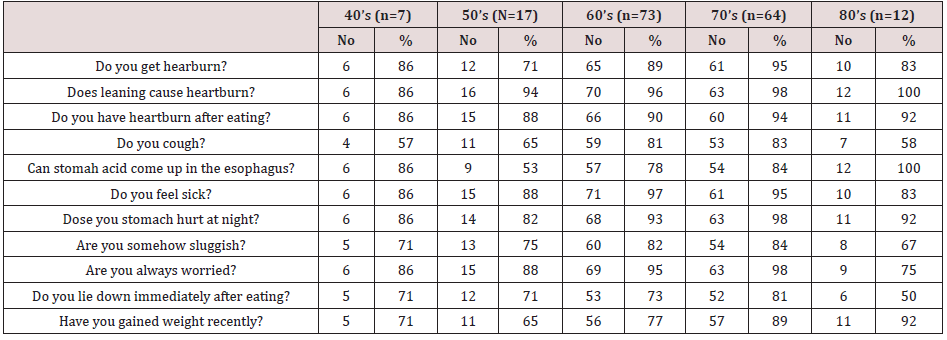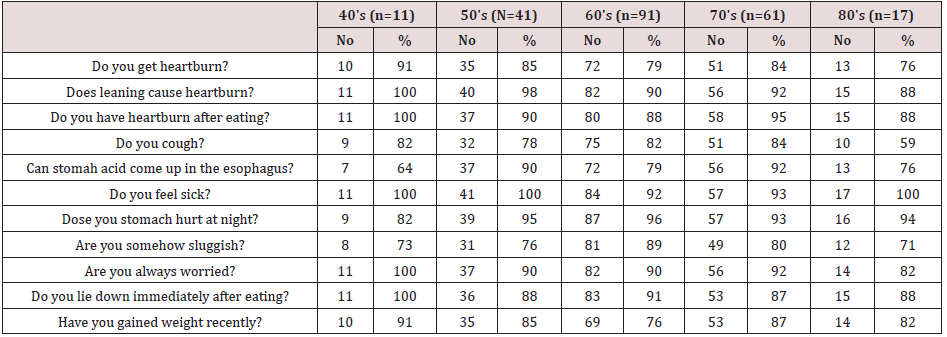
Lupine Publishers Group
Lupine Publishers
Menu
ISSN: 2638-6070
Research Article(ISSN: 2638-6070) 
Gastroesophageal Reflux Disease (GERD) Questionnaire Survey in Yakumo Town Resident’s Health Examination (2011)
Volume 3 - Issue 4Naomi Katayama1,2,3*
- 1Nagoya Women’s University, Japan
- 2Graduate School of Nagoya Women’s University, Japan
- 3Department of Otorhinolaryngology, Nagoya University Graduate School of Medicine, Japan
Received: December 11, 2020; Published: December 22, 2020
*Corresponding author: Naomi Katayama, Department of Otorhinolaryngology, Nagoya University Graduate School of Medicine, Nagoya Women’s University, Japan
DOI: 10.32474/SJFN.2020.03.000170
Abstract
Japanese society is aging, and daily life is carried out under stressful conditions. Therefore, the number of patients with gastroesophageal reflux disease (GERD) has increased to the same level as in Europe and United States. Therefore, in this study, we report on a self-administered questionnaire survey that asked questions about GERD at the annual resident health examination in Yakumo Town, Hokkaido, Japan, where there is almost no population movement. Participants were 151 males and 221 females. As a result, males had statistically significantly lower values for the question (Do you lie down immediately after eating?) than females. It was also found that males in their 50s complain of GERD symptoms statistically significantly more than females in their 50s. It was also found that males complain of GERD in their 50s compared to those in their 60s and 70s. In the future, it will be necessary to check eating habits and dietary content.
Keywords: Healthy Elderly People; Questionnaire Survey; Gerd; Residents’ Health Examination
Introduction
Japan is a super-aging society, and the working population is also leaning toward the elderly, and the entire society is moving toward the retirement age of 70. In today’s stressful society, the number of patients with gastroesophageal reflux disease (GERD) is increasing [1]. With GERD, heartburn continues, and quality of life is compromised [2,3]. Therefore, the purpose of this study was to understand the actual situation by asking questions about GERD using a self-administered questionnaire survey at the annual resident health examination in Yakumo Town, Hokkaido, Japan, where there is almost no population movement.
Material and Methods
Participants
A questionnaire survey was conducted among the participants of the Yakukmo Town Residents’ Health Examination, among the participants who consulted the otolaryngology department.
Questionnaire survey
There were a total of 11 items in the questionnaire survey on Reflux esophagitis. The questionnaire was self-administered to the participants. The contents of the question show below.
1) Do you get hearburn?
2) Does leaning cause heartburn?
3) Do you have heartburn after eating?
4) Do you cough?
5) Can stomah acid come up in the esophagus?
6) Do you feel sick?
7) Dose you stomach hurt at night?
8) Are you somehow sluggish?
9) Are you always worried?
10) Do you lie down immediately after eating?
11) Have you gained weight recently?
Results
Participants Age and Sex
The number of participants in the otolaryngology area of the Yakumo Town Residents Examination in 2010 was 151 males and 221 females (Table 1). Looking at the participants by age group, males were most likely to participate in their 60’s (73 peoples), and females were most likely to be in their 60’s (91 peoples).
Questionnaire Survey Results
Table 2 shows the results of a self-administered questionnaire survey on 11 types of GERD conducted on males. And also, Table 3 shows the results of a self-administered questionnaire survey on 11 types of GERD conducted on females. Both tables show the number and percentage of participants who answered that they had no symptoms of GERD for each question by age group. Based on these results, Table 4 shows whether there is a statistically significant difference between males and females in each question. As a result, for the 10th question (Do you lie down immediately after eating?), males showed statistically significant GERD symptoms compared to females (P<0.0054**). In addition, Table 5 shows the results of a statistical comparison of the answers to the questions regarding male and female GERD during each age group. In their 50s, males had statistically significant GERD symptoms compared to females (P<0.0118*). Table 6 shows the statistical processing results between age groups for each gender. Females were not statistically significant in all age combinations. However, males were statistically significantly different in their 40s and 70s (P<0.0044**), 50s and 60s (P<0.0408*), and 50s and 70s (P<0.0030**). Males in their 70s had statistically significantly worse answers to GERD-related questions than 40s, and 50s had statistically significantly worse answers to GERD-related questions than those in their 60s and 70s.
Table 2: Participant’s answer to the question about gasfroesophageal reflux in Yakumo study 2011 years (Male=151) Average age ± standard deviation=66.35±9.73.

Table 3: Participant’s answer to the question about gasfroesophageal reflux in Yakumo study 2011 years (Female=221) Average age ± standard deviation=65.55±9.61.

Table 4: Conparison of male and female answers to 11 questions about mastication (Unpaired t-test).

*=P<0.05, **=P<0.01
Table 6: Comparison between ages for 11 questions regarding gatroesophageal reflux.

Unpaired t-test * = P<0.05, ** =P<0.01
Discussion
We asked questions about GERD in a self-administered questionnaire survey at the annual resident health examination in Yakumo Town, Hokkaido, Japan, where the population dose not fluctuate. As a result of comparing the answers to the 10 of the 11 questions regarding GERD between males and females, there was no statistically significant difference. In only one item (Q10: Do you lie down immediately after eating?), males showed statistically significantly worse values than females. Apparently, the male is lying down and relaxing immediately after eating. Females are unlikely to lie down because they wash and clean the dishes after eating. It may be that the division of roles within the Japanese family is emerging. A comparison between males and females showed that in their 50s, males had statistically significantly worse results of GERD questions than females. Men in their 50s are more likely to work as managers and are more likely to develop GERD symptoms due to stress. As a result of comparing the ages of males, the results of questions about GERD in the 50s are worse than those in the 60s and 70s, so GERD symptoms are more likely to occur because the age at work is stressful. The disease impairs quality of life and is followed by heartburn [2,3]. The number of patients with gastroesophageal reflux disease (GERD) in Japan is increasing, and it is currently reported to be comparable to the frequency in Europe and the United States [1]. In the elderly, the muscles of the whole body are weakened [4,5] (examples include sarcopenia [6,7], frail, etc.). The elderly cardia is loosened, and gastric acid and stomach contents flow back into the esophagus after eating, which may cause aspiration pneumonia in some cases. GERD is related to meal content, especially fatty food, it is necessary to increase the number of self-administered questionnaire survey items in the future to understand the situation. Undernutrition also has a systemic effect on the elderly [8,9]. We also need to collect more data on the dietary intake of the elderly.
Conclusion
A self-administered questionnaire survey on GERD was conducted at the annual Yakumo Town Residents’ Health Examination. Participants were 151 males and 221 females. As a result, there was a statistically significant difference between males and females in one of the 11 questions regarding GERD. In addition, as a result of comparing the answers to the questions in each age group between males and females, males in their 50s showed statistically significant GERD symptoms compared to females. Males in their 50s had statistically significant GERD symptoms compared to those in their 60s and 70s. It is expected that males in their 50s are living a stressful life. In the future, we think it will be necessary to investigate eating habits and dietary content.
Acknowledgement
We would like to express our deep gratitude of everyone in Yakumo Town for their cooperation in conducting this research. This research was carried out with a research grant from the Japanese Grant-in-Aid for Scientific Research, Basic Research C (22500779). The data entry and summary of this research was carried out by the Japanese Grant-in-Aid for Scientific Research, Basic Research C (20K02372).
References
- Furukawa N, Iwakiri R, Koyama T (1999) Proportion of reflux esophagitis in 6010 Japanese adults: prospective evaluation by endoscopy. J Gastroenterol 34(4): 441-444.
- Tew S, Jamieson GG, Pilowsky I (1997) The illness behavior of patients with gastroesophageal reflux disease with and without endoscopic esophagitis. Dis Esophagus 10(1): 9-15.
- Dimenas E, Glise H, Hallerback B (1995) Wellbeing and gastrointestinal symptoms among patients referred to endoscopy owing to suspected duodenal ulcer. Scand J Gastroenterol 30(11): 1046-1052.
- Hudson HM, Daubert CR, Mills RH (2000) The interdependency of protein-energy malnutrition, aging, and dysphagia. Dysphagia 15(1): 31-38.
- Rogers MA, Evans WJ (1993) Changes in skeletal muscle with aging: effects of exercise training. Exerc Sport Sci Rev 21: 65-102.
- Chen LK, Liu LK, Woo J (2014) Sarcopenia in Asia: consensus report of the Asian Working Group for Sarcopenia. J AM Med Dir Assoc 15(2): 95-101.
- Anker SD, Morley JE, von Haehling s (2016) Welcome to the ICD-10 code for sarcopenia. J Cachexia Sarcopenia Muscle 7(5): 512-514.
- Roubenoff R, Hughes VA (2000) Sarcopenia: current concepts. J Gerontol a Biol Sci Med Sci 55(12): M716-724.
- Carmeli E, Coleman R, Reznick AZ (2002) The biochemistry of aging muscle. Exp Gerontol 37(4): 477-489.

Top Editors
-

Mark E Smith
Bio chemistry
University of Texas Medical Branch, USA -

Lawrence A Presley
Department of Criminal Justice
Liberty University, USA -

Thomas W Miller
Department of Psychiatry
University of Kentucky, USA -

Gjumrakch Aliev
Department of Medicine
Gally International Biomedical Research & Consulting LLC, USA -

Christopher Bryant
Department of Urbanisation and Agricultural
Montreal university, USA -

Robert William Frare
Oral & Maxillofacial Pathology
New York University, USA -

Rudolph Modesto Navari
Gastroenterology and Hepatology
University of Alabama, UK -

Andrew Hague
Department of Medicine
Universities of Bradford, UK -

George Gregory Buttigieg
Maltese College of Obstetrics and Gynaecology, Europe -

Chen-Hsiung Yeh
Oncology
Circulogene Theranostics, England -
.png)
Emilio Bucio-Carrillo
Radiation Chemistry
National University of Mexico, USA -
.jpg)
Casey J Grenier
Analytical Chemistry
Wentworth Institute of Technology, USA -
Hany Atalah
Minimally Invasive Surgery
Mercer University school of Medicine, USA -

Abu-Hussein Muhamad
Pediatric Dentistry
University of Athens , Greece

The annual scholar awards from Lupine Publishers honor a selected number Read More...






